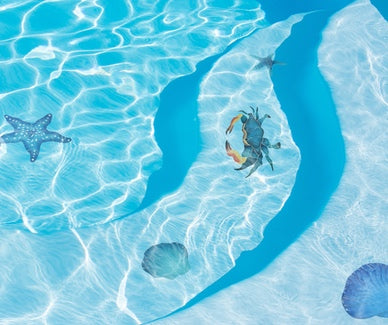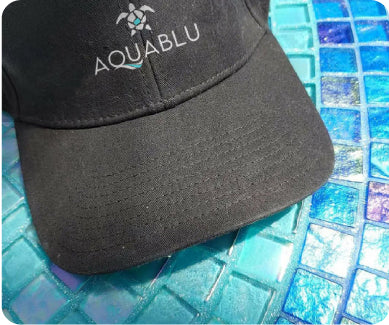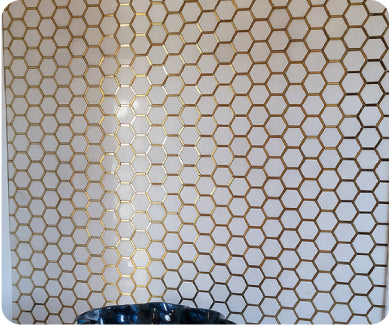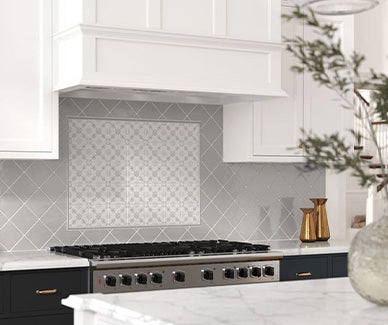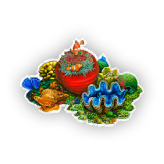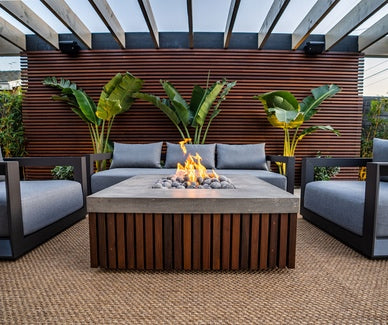Battle of the Fish Mosaic Tile: Herringbone Tile vs. Fish Scale Tile

Both glass tile patterns have much to offer – but is one better? You decide...
Two of the hottest trends in mosaic tile design have to do with, uh – fish. Both the Moroccan fish scale tile and herringbone tile patterns have become popular mosaic tiles for backsplashes, baths, niches, walls and even floors.
And no wonder given their creative design possibilities and wide range of colors.
Moroccan fish scale tile is also known as fan tile, scallop tile, wave tile, ogee drops and even mermaid tile. No matter what you call it, this compelling mosaic tile was created to be visually pleasing with a tip that is neither too sharp nor broad and a balance of overall width and height on each tile that makes them flow in all directions – much like the fish or water they represent.
The herringbone pattern is an arrangement of rectangles so named for a fancied resemblance to the bones of a fish such as a herring. The blocks can be rectangles or parallelograms. The block edge length ratios are usually 2:1, and sometimes 3:1, but need not be even ratios.
The herringbone tile pattern was originally used to jazz up standard wood floors. But it’s now making a name for itself in bathrooms and kitchens alike.
Your choice of herringbone tile or fish scale tile is largely a personal one based on how you plan on using these outstanding mosaic tiles.
Here are some benefits of each to consider:
Fish Scale Tile

Dating back to the eighth century, Moroccan Fish Scales are a staple of contemporary Moorish and Mediterranean style. Their unique shape is beautifully versatile—whether you choose one color or many, these tiles are full of romance and visual impact.
Glass fish scale tile by Vidrepur, a company which makes mosaic tile from recycled glass in Spain, has many applications. One popular way to incorporate fish scale tile is to use aqua tiles or blue glass tile with the fish scale tile pattern for a shower wall or bath backsplash. The cool colors and laid back design create a micro environment that says time to relax.
A mix of aqua tiles and blue glass tiles in the fish scale tile pattern makes a nice look for bathroom niches or under counter island wall areas in kitchens.
Cashing in on the white subway tile popularity, white fish scale tile by Vidrepur also provides a clean, classic look for above counter kitchen spaces as well as kitchen backsplashes. If you want a more dramatic look, you can use an epoxy glass tile colored grout to match other design elements and colors of your kitchen.
At the other end of the spectrum, black fish scale tiles add a stylish, sophisticated touch to kitchen backsplashes or areas below or above counters. This classy glass tile is especially impactful when contrasted with white or light colored counter tops or paint.
People who enjoy fish scale mosaic glass tile like the fact that this is a very versatile tile pattern that can be used with the tip pointing up or pointing down. It appears that having a fish scale tile pattern pointing one direction or the other is a personal preference, although some swear that fish scale tile tips pointing up bring about an elevated energy.
For a truly exotic, wavy feel, you can also place fish scale tile pointing up, pointing down and pointing sideways – all in the same space.
Other qualities about fish scale tiles that receive high marks from consumers, include:
- Fish scale tiles are an easy way to inject a bit of fun into your kitchen, bathroom or floor. While other styles of glass mosaic tile can look fun, fish scale tiles do it the most effortlessly.
- Fish scale tiles can add many different colors and color tones to your space beyond aqua tiles and blue glass tiles. Like real scales on a fish, varying tones of similar colors can create a dynamic and unique look that other glass tiles won’t be able to achieve.
- Fish scale tiles can add a unique texture to your space.
Herringbone Tile

Essentially, a herringbone tile pattern is made up of rectangular tile pieces that meet at perfect straight edges to form a “zigzag” pattern. Because it uses rectangular tiles instead of angled tiles, the herringbone tile pattern will look broken or staggered, so that the resulting design holds its own sort of asymmetrical, eye-catching appeal.
While herringbone tile is usually laid at a 45 degree angle to the floor or wall that it adjoins, laying it horizontally can create a unique, unusual design that makes the pattern really pop!
Herringbone tile can make the simplest spaces look more eye-catching. A plain white tile, if laid in a herringbone pattern, can elevate the space that you’re remodeling.
Depending on both the grout and tile color, as well as the size of tiles used, the pattern can be obvious, or it can be more muted.
The herringbone tile pattern provides a fun twist as well as a compelling and endearing mosaic tile design.
An especially striking herringbone tile is our blue and gray mix Moonlight glass tile. This herringbone tile is a great fit for wall to ceiling long, narrow walls, especially if the surrounding walls are white or off-white. This is also a nice pattern for below counter center islands or kitchen backsplashes.
Another idea that is picking up steam involves using the herringbone tile pattern as a pattern within a pattern. For example, for a truncated wall area such as found over a stove, you could do the wall in a white subway tile pattern but frame the center in a white herringbone tile.
A similar effect can be created by using a blue glass tile herringbone pattern centered in a blue subway tile pattern, but this time turning the zigzag sideways. By laying your herringbone tile pattern in a vertical arrangement you create an effortless contemporary aesthetic.
--------------
Have questions about fish mosaic tile patterns – or anything else on your mind? Talk to one of our experts. You can call us at (800) 971-1442 or fill out our contact form. You can visit our website at https://www.aquablumosaics.com/.



























